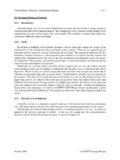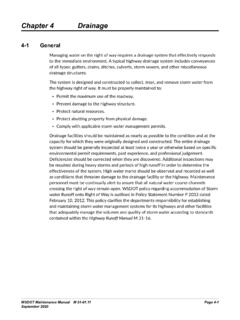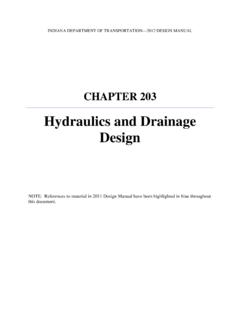Transcription of HYDROLOGIC & HYDRAULIC CONSIDERATIONS FOR …
1 HYDROLOGIC & HYDRAULIC CONSIDERATIONS FOR PLANNING AND DESIGN OF CULVERTS FOR ROAD drainage S. K. Mazumder, Adviser (Former AICTE Em. Prof. of CE, DCE) E-mail: & Subhashis Mukherjee,General Manager E-mail: ICT Pvt. Ltd., A-8 Green Park, New Delhi) Abstract Several new road Schemes as well as up-gradation of existing roads are being undertaken by the Govt. of India for better and faster communication amongst the different parts of the country. drainage of road is an important aspect of road project for the purposes of safety, speed, maintenance and life span of the road. Design of culverts which is an integral part of any road drainage scheme is to be done scientifically for efficient functioning. The paper outlines the various data to be collected from different sources for proper planning and design of culverts and deciding their location, type and size for new roads as well for up-gradation of existing ones.
2 Different hydrological and HYDRAULIC CONSIDERATIONS including use of software involved in the design of culverts have been discussed at length. Key Words: culvert , Controls, Design Flood, Improved Inlet, Head water, Velocity 1 INTRODUCTION Govt. of India has an ambitious plan of connecting different parts of our country by constructing a network of national highways, state and village roads under various development schemes Golden quadrilaterals, North-South & East West Corridors, Gram Sadak Yojna , NREGP, Bharat Nirman etc. Apart from construction of new roads, the Government s policy is to also upgrade the existing roads for developing an efficient road communication system. Roads and similar other infrastructures, built with public money, are our national assets and they must be preserved and protected for the benefit of the people. drainage of road is one of the many components of a road project.
3 The objective of road drainage is to remove the storm water as rapidly as possible so that traffic may move safely and efficiently without any loss of time. Speedy disposal of the storm water runoff likely to be accumulated due to construction of the road embankment is very important for the success of a road project from technical and environmental points of view. Inadequate drainage invariably results in reduction of life span of a road, increase in maintenance cost and drainage congestion in the countryside leading to submergence of land and consequent loss of agricultural and other properties. Provision of culverts of adequate size and numbers in a road drainage scheme - whether the road is a new one or an up-gradation of an existing one - is intimately related to the health and safety of the road. Depending on terrain conditions and the magnitude and intensity of rainfall, cost of roadside drains and drainage culverts in Indian road projects is generally around 4% to 5% of the total project cost.
4 However, due importance is generally not given for proper planning, HYDRAULIC design and construction of road drainage and drainage culverts in Indian road projects commensurate with the role the drains and culverts play in protecting the road and safeguarding the interest of the project as a whole. The main purpose of writing this paper is to emphasize some important HYDROLOGIC and HYDRAULIC CONSIDERATIONS involved in proper planning and efficient design of drainage culverts. IRC: SP:42 (1994) and IRC:SP:13 (2004) give guidelines for design of road drainage and drainage culverts respectively. IRC: SP:50 (1999) and IRC: SP:48 (1998) are meant for design of urban road drainage and hill road drainage respectively. In an earlier paper (under review by IRC), Mazumder (2009) has discussed about the optimum spacing and design of culverts in a hilly terrain.
5 In this paper, authors have emphasized upon the various HYDROLOGIC and HYDRAULIC aspects for proper planning and design of culverts for road drainage . 2. NECESSITY OF drainage CULVERTS Construction of a road embankment unavoidably obstructs and interferes with the natural overland flow and flow through the natural channels rivers, nallas, canals, drains etc. Suitable bridge / culvert openings under the road should, therefore, be provided across these channels with a view to pass the peak discharge through the channels without causing harmful afflux and disturbing the natural flow regime. Provision of adequate numbers of culverts of appropriate size is a prerequisite for a healthy road. Submergence and overtopping of road not only causes damage to the road and road structures, it results in disruption of traffic, loss of travel time and miseries to many of the poor people who take shelter on roads during floods in many parts of our country.
6 Overland flow, which would otherwise meet the natural stream at some downstream point, must be intercepted in longitudinal drains and discharged back into the nearest natural drainage channel through culverts and bridges. The local drainage arrangements consisting of longitudinal drains and culverts shall have to be designed to carry the runoff from the road surface too. Where a road runs in an undulating terrain, causeways or dips are often provided in valleys to avoid road in high embankment. Frequent dipping down from high road levels to the ground produces a very undesirable road profile. Constructing bridges and culverts under road in high embankment is a better proposition than providing so many dips and causeways leading to disruption in traffic movement during flood season. Bridges, culverts and underpasses are often used by local people and livestock to cross the busy roads like national and state highways in high embankments.
7 They also act as passage for up and down movement of fish and other aquatic animals. Sediments and debris carried by the stream, especially during floods, must freely move downstream through these openings to avoid aggradations and other interrelated problems (MOWR,2004). For existing roads, it is not uncommon to find silted barrels of existing culverts and culverts having inadequate capacities causing overtopping of the road embankments. In a very flat terrain, most of the streams are shallow and the banks are spilled with flood water moving in wide flood plains. In the absence of road, the spill flow moving over the land surface constitutes a substantial amount of peak flood. When a road is built in such a terrain with wide flood plains, the entire flood water has to move across the road through the bridge opening of limited span, resulting in very high afflux and other problems (Mazumder et al,2002).
8 Usually, the spill water is found to move along the toe of the road causing scouring and damage to road embankment. Provision of relief culverts on either side of the bridges in such flood plains are very helpful in the quick disposal of spill flood across the road which results in less afflux and ensures safety of the road embankment. 3 PLANNING OF CULVERTS FOR EFFECTIVE ROAD drainage Design of an efficient cross- drainage system is a prerequisite for success of new road projects and for rehabilitation projects as well. Proper planning of culverts is a very important aspect of road design from the point of view of safety of the road - new or existing one. Planning generally covers selection of location, type, numbers and size of culverts. Location of Culverts To be most effective, location of culverts have to be very carefully decided after studying the terrain and collecting relevant information from toposheets and other sources.
9 Field visit and consultation with local people and local authorities conversant with local topography and drainage problem of the area is extremely useful. Location of Culverts for new road projects A drainage culvert should be placed in a natural depression or valley points. These locations are easily identifiable in hilly / rolling terrains but very difficult to be identified in plains. An easy method of identifying the depression / valley and direction of flow is contour study of the project road corridor and a site visit to study drainage pattern of the area. The ground level elevations along the toe of the road on upstream and downstream (L-Profile) should identify the natural dips and thus suitable culvert locations and direction of flow. It is mandatory to ensure a path for the runoff to reach the outfall point from culvert outlet either through existing channel or roadside ditches or by overland flow.
10 Flow coming out of the culvert must not get accumulated at its outlet jeopardizing the safety of the road embankment. Downstream canalization, wherever feasible, may also be thought of to avoid such accumulation of water. In the hilly terrains, culvert locations are identified directly from the presence of streamlets, not big enough to be spanned by a bridge. In the stretches where the road is planned by cutting hill slopes, innumerable streamlets come down the hill slopes cross the proposed road. Runoff water and sediments from such streamlets must be disposed off either directly through culverts at the crossings and/or intercepted by longitudinal drains and disposed off in to the valley through closely spaced intermediate culverts with a view to limit the drain size. Optimum spacing of culverts in a hilly terrain has been worked out in another paper by the first author (Mazumder,2009).





